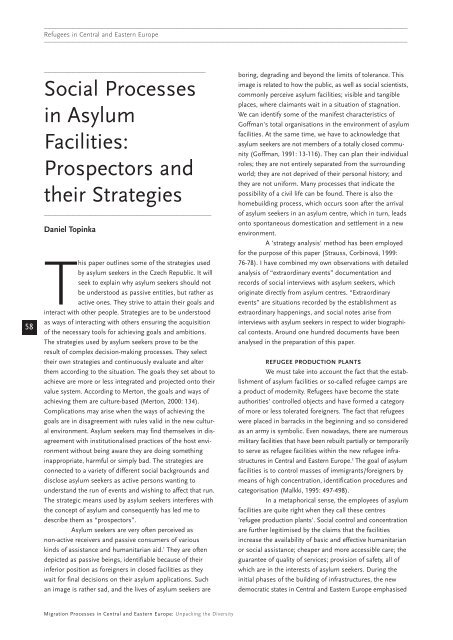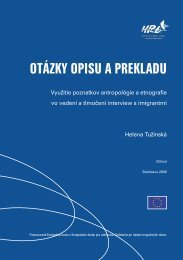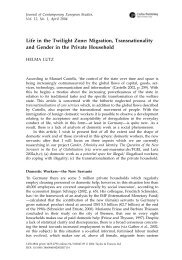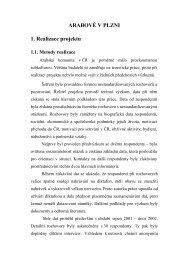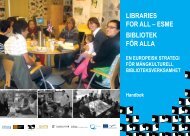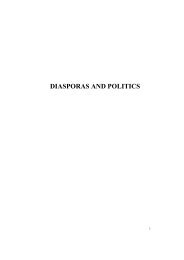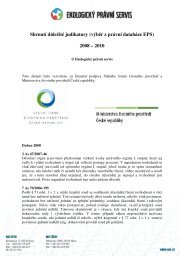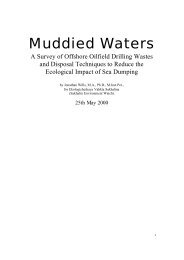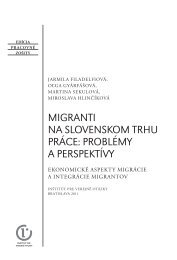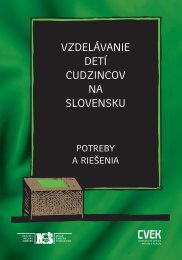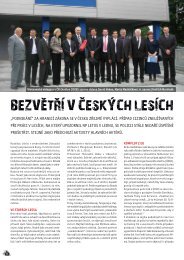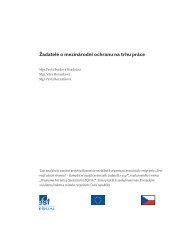Migration Processes in Central and Eastern Europe - Multiple Choices
Migration Processes in Central and Eastern Europe - Multiple Choices
Migration Processes in Central and Eastern Europe - Multiple Choices
Create successful ePaper yourself
Turn your PDF publications into a flip-book with our unique Google optimized e-Paper software.
———————————————————————————————————————————————————————————————<br />
Refugees <strong>in</strong> <strong>Central</strong> <strong>and</strong> <strong>Eastern</strong> <strong>Europe</strong><br />
———————————————————————————————————————————————————————————————<br />
58<br />
————————————————————————————<br />
Social <strong>Processes</strong><br />
<strong>in</strong> Asylum<br />
Facilities:<br />
Prospectors <strong>and</strong><br />
their Strategies<br />
—————————————————————————————<br />
Daniel Top<strong>in</strong>ka<br />
This paper outl<strong>in</strong>es some of the strategies used<br />
by asylum seekers <strong>in</strong> the Czech Republic. It will<br />
seek to expla<strong>in</strong> why asylum seekers should not<br />
be understood as passive entities, but rather as<br />
active ones. They strive to atta<strong>in</strong> their goals <strong>and</strong><br />
<strong>in</strong>teract with other people. Strategies are to be understood<br />
as ways of <strong>in</strong>teract<strong>in</strong>g with others ensur<strong>in</strong>g the acquisition<br />
of the necessary tools for achiev<strong>in</strong>g goals <strong>and</strong> ambitions.<br />
The strategies used by asylum seekers prove to be the<br />
result of complex decision-mak<strong>in</strong>g processes. They select<br />
their own strategies <strong>and</strong> cont<strong>in</strong>uously evaluate <strong>and</strong> alter<br />
them accord<strong>in</strong>g to the situation. The goals they set about to<br />
achieve are more or less <strong>in</strong>tegrated <strong>and</strong> projected onto their<br />
value system. Accord<strong>in</strong>g to Merton, the goals <strong>and</strong> ways of<br />
achiev<strong>in</strong>g them are culture-based (Merton, 2000: 134).<br />
Complications may arise when the ways of achiev<strong>in</strong>g the<br />
goals are <strong>in</strong> disagreement with rules valid <strong>in</strong> the new cultural<br />
environment. Asylum seekers may f<strong>in</strong>d themselves <strong>in</strong> disagreement<br />
with <strong>in</strong>stitutionalised practices of the host environment<br />
without be<strong>in</strong>g aware they are do<strong>in</strong>g someth<strong>in</strong>g<br />
<strong>in</strong>appropriate, harmful or simply bad. The strategies are<br />
connected to a variety of different social backgrounds <strong>and</strong><br />
disclose asylum seekers as active persons want<strong>in</strong>g to<br />
underst<strong>and</strong> the run of events <strong>and</strong> wish<strong>in</strong>g to affect that run.<br />
The strategic means used by asylum seekers <strong>in</strong>terferes with<br />
the concept of asylum <strong>and</strong> consequently has led me to<br />
describe them as “prospectors”.<br />
Asylum seekers are very often perceived as<br />
non-active receivers <strong>and</strong> passive consumers of various<br />
k<strong>in</strong>ds of assistance <strong>and</strong> humanitarian aid. 1 They are often<br />
depicted as passive be<strong>in</strong>gs, identifiable because of their<br />
<strong>in</strong>ferior position as foreigners <strong>in</strong> closed facilities as they<br />
wait for f<strong>in</strong>al decisions on their asylum applications. Such<br />
an image is rather sad, <strong>and</strong> the lives of asylum seekers are<br />
bor<strong>in</strong>g, degrad<strong>in</strong>g <strong>and</strong> beyond the limits of tolerance. This<br />
image is related to how the public, as well as social scientists,<br />
commonly perceive asylum facilities; visible <strong>and</strong> tangible<br />
places, where claimants wait <strong>in</strong> a situation of stagnation.<br />
We can identify some of the manifest characteristics of<br />
Goffman's total organisations <strong>in</strong> the environment of asylum<br />
facilities. At the same time, we have to acknowledge that<br />
asylum seekers are not members of a totally closed community<br />
(Goffman, 1991: 13-116). They can plan their <strong>in</strong>dividual<br />
roles; they are not entirely separated from the surround<strong>in</strong>g<br />
world; they are not deprived of their personal history; <strong>and</strong><br />
they are not uniform. Many processes that <strong>in</strong>dicate the<br />
possibility of a civil life can be found. There is also the<br />
homebuild<strong>in</strong>g process, which occurs soon after the arrival<br />
of asylum seekers <strong>in</strong> an asylum centre, which <strong>in</strong> turn, leads<br />
onto spontaneous domestication <strong>and</strong> settlement <strong>in</strong> a new<br />
environment.<br />
A 'strategy analysis' method has been employed<br />
for the purpose of this paper (Strauss, Corb<strong>in</strong>ová, 1999:<br />
76-78). I have comb<strong>in</strong>ed my own observations with detailed<br />
analysis of “extraord<strong>in</strong>ary events” documentation <strong>and</strong><br />
records of social <strong>in</strong>terviews with asylum seekers, which<br />
orig<strong>in</strong>ate directly from asylum centres. “Extraord<strong>in</strong>ary<br />
events” are situations recorded by the establishment as<br />
extraord<strong>in</strong>ary happen<strong>in</strong>gs, <strong>and</strong> social notes arise from<br />
<strong>in</strong>terviews with asylum seekers <strong>in</strong> respect to wider biographical<br />
contexts. Around one hundred documents have been<br />
analysed <strong>in</strong> the preparation of this paper.<br />
REFUGEE PRODUCTION PLANTS<br />
We must take <strong>in</strong>to account the fact that the establishment<br />
of asylum facilities or so-called refugee camps are<br />
a product of modernity. Refugees have become the state<br />
authorities' controlled objects <strong>and</strong> have formed a category<br />
of more or less tolerated foreigners. The fact that refugees<br />
were placed <strong>in</strong> barracks <strong>in</strong> the beg<strong>in</strong>n<strong>in</strong>g <strong>and</strong> so considered<br />
as an army is symbolic. Even nowadays, there are numerous<br />
military facilities that have been rebuilt partially or temporarily<br />
to serve as refugee facilities with<strong>in</strong> the new refugee <strong>in</strong>frastructures<br />
<strong>in</strong> <strong>Central</strong> <strong>and</strong> <strong>Eastern</strong> <strong>Europe</strong>. 2 The goal of asylum<br />
facilities is to control masses of immigrants/foreigners by<br />
means of high concentration, identification procedures <strong>and</strong><br />
categorisation (Malkki, 1995: 497-498).<br />
In a metaphorical sense, the employees of asylum<br />
facilities are quite right when they call these centres<br />
'refugee production plants'. Social control <strong>and</strong> concentration<br />
are further legitimised by the claims that the facilities<br />
<strong>in</strong>crease the availability of basic <strong>and</strong> effective humanitarian<br />
or social assistance; cheaper <strong>and</strong> more accessible care; the<br />
guarantee of quality of services; provision of safety, all of<br />
which are <strong>in</strong> the <strong>in</strong>terests of asylum seekers. Dur<strong>in</strong>g the<br />
<strong>in</strong>itial phases of the build<strong>in</strong>g of <strong>in</strong>frastructures, the new<br />
democratic states <strong>in</strong> <strong>Central</strong> <strong>and</strong> <strong>Eastern</strong> <strong>Europe</strong> emphasised<br />
<strong>Migration</strong> <strong>Processes</strong> <strong>in</strong> <strong>Central</strong> <strong>and</strong> <strong>Eastern</strong> <strong>Europe</strong>: Unpack<strong>in</strong>g the Diversity


